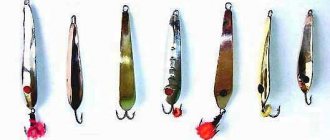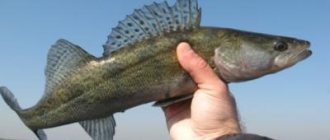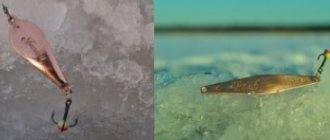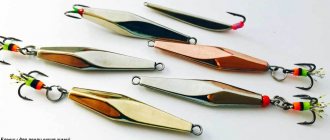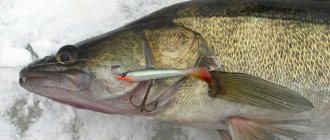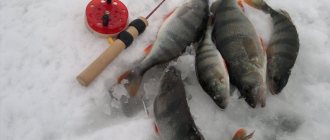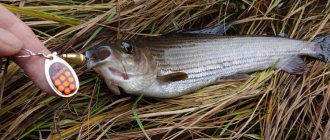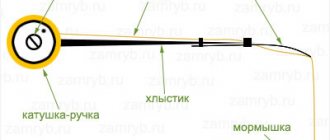Production technology
The material used to make the spinners is high-quality brass. Thanks to it, baits have:
- Corrosion resistant
- High level of strength and flexibility,
- Good sounding.
The company produces up to 7 thousand baits per hour from brass sheets. There they undergo galvanization, a process in which positive and negative particles take part. At the end of production, the spoon is coated with nickel and copper, which increase its service life. Only after this a layer of silver or gold is applied to the finished bait.
Williams baits are also valued for their excellent light perception, thanks to which they will be visible even at a depth of more than 5 meters. It is worth noting that Williams lures can remain in new condition for many years, which is why they have a high cost.
A little history
Williams spinners are manufactured by a Canadian company. It was founded in 1916 by brothers with the last name Williams. In the past, the brothers were known as successful miners of gold ore, but they became passionate about fishing. They began to coat brass spoons with precious metals: gold and silver. This allowed them to achieve maximum catchability.
The production of Williams spinners includes complex 24 technological stages. Each tackle is made of high quality brass. This metal is not afraid of water and does not oxidize under its influence. Brass creates the necessary oscillatory circuit that attracts fish, and silver or gold provides the tackle with a final, reliable and shiny coating that imitates fish scales.
Varieties of spinners
There are many varieties of Williams spinners. The choice of bait depends on the individual characteristics of the reservoir, as well as the fish being fished for.
It is worth noting that the Williams spinner has the best effect on pike perch. This is due to the fact that most Williams lures have a shape and color that appeals most to pike perch. When fishing for pike perch at shallow depths, a smooth horizontal retrieve is best. Pauses lasting no more than 2 seconds will only cause additional interest in the predator. For fishing at a depth of more than 5 meters, it is recommended to use vertical wiring (as with jig fishing).
There is also a large assortment of Williams spinners for winter fishing. They are different from those used for fishing in the summer. This is due to the fact that in winter fishing horizontal fishing is used, and in summer fishing - vertical. The most popular Williams spinners used for winter fishing are:
- Rocker-shaped. The peculiarity of this bait is that its center of gravity is located in the hole for the fishing line. The location of the hooks in the nozzle is double-sided (top and bottom).
- Vertical. The vertical Williams spinner is a metal plate. On one side there is a hole for threading fishing line, and on the other there is one or more hooks.
- "The Dragon". The nozzle is quite massive and large. It is not particularly popular among fishermen. If the fish falls off, it can be seriously injured.
Williams spinners can also be distinguished by color. The most common of them are:
- GN (gold)
- SN (silver),
- COP (brown)
- HN (half gold, half silver),
- EB (half blue, half white).
The fish are most interested in the blue and white bait. The fact is that when retrieving, the white half of the nozzle throws off glare that attracts fish. The purpose of the second half is to make the lure as similar as possible to a live fish.
Tips from anglers
There are several tips regarding the Williams wabler spoon. The best recommendations from anglers are:
- It is recommended to purchase Williams products only from official representatives or trusted sellers. When purchasing bait online, special attention should be paid to the authenticity of the product. A Chinese copy will be much cheaper, but will be of low quality and have a short service life.
- If the bait is chosen for catching pike perch, then it is worth considering that its diet usually includes fish whose length is 4 times greater than their width. For this reason, the lure must be chosen in the same size.
- In winter, the activity of fish decreases significantly, so even in warm weather it is necessary to study the places where they stay, since in winter it will be much more difficult to find them
Williams spinners are gaining more and more popularity every day. They perfectly combine price and quality, which makes them the choice of most spinners.
Most popular models
The Williams spinner range is quite wide. The most popular models are:
- W 30. The bait has the smallest dimensions. With a length of 4 cm, its weight is only 4 g. It is used for catching small-sized predators at shallow depths.
- W 40. The weight of the model is 7 g and the length is 5.7 cm. Most often used for catching pike and pike perch at small and medium depths.
- W 50. A special feature is the presence of beautiful and smooth wiring. The length of the spoon is 8.3 cm and weighs 14 g. It is used for catching large specimens.
- W 60. The W 60 spinner is considered a medium-sized model. Its length is 8.3 cm and its weight is 21 g. It is used for fishing in bays and ponds at medium depths. Most often pike perch are caught with it, but sometimes other predators are caught.
- W 70. The spoon is the largest, but at the same time less popular. Its weight is as much as 30 g and its length is 11 cm. Large specimens are caught with it near the bottom of the reservoir.
- Lite W 55. The model entered the market relatively recently. Thanks to its excellent weight-to-length ratio (7g x 6.5cm), it glides beautifully when retrieved. Shows the best results when fishing for pike perch and pike.
Do-it-yourself spinners for pike perch in winter
Before making a catchy homemade spoon with your own hands, it is important to pay attention to the selection of materials for production.
Required:
- metal sheet (brass, steel, copper);
- black marker;
- soldering acid;
- burner;
- wooden board
- a piece of tin;
- pliers;
- file;
- sandpaper;
- soldering iron;
- hooks No. 3-5.
The spinner manufacturing process is step-by-step:
- Draw 2 oblong contours on a metal sheet for the future spinner. When fishing for medium-sized pike perch, the approximate length of the spoon will be 7-8 cm, width - 10-15 mm.
- Draw the lure on the metal with a black marker.
- Cut with scissors.
- Carefully trim the spoon on all sides with a file.
- Take acid and treat the cut sheet.
- Apply a thin layer of tin.
- Take a hook and bite off a ring with pliers.
- Heat the tip of the hook with a torch, holding it with pliers.
- Heat all parts of the hook by placing it on a wooden board.
- Make small folds and cool.
- Solder the ring with the hook to the base of the future bait so that the loop and the sting of the hook remain symmetrical.
- Cut 2/3 of the total length of the spinner from a lead sheet and slightly narrower by 2-3 mm.
- Trim the edges , place the sheet on the prepared spoon so that it can roll from side to side in the water without difficulty.
- Take the second part of the spoon and place it on top of the first.
- Solder around the circumference using a soldering iron, especially at the hook and loop area.
- Bring it to a shine and clean the resulting lure with sandpaper.
Fishing technique
First of all, it is worth noting that pike perch can be caught both in summer and winter. Fishing at every time of the year has its own subtleties and characteristics.
For winter fishing, vertical Williams spinners are used. They, of course, have not gained as much popularity as baits for summer fishing, but they show excellent results.
There are several rules for wiring, following which the likelihood of catching a predator will increase. They are:
- Fast fall of the bait. The spoon should quickly sink to the bottom of the reservoir. For this reason, it is best to choose heavier models. The fall time should not exceed 3 − 4 seconds. If, during the fall, even the slightest bite was noticed, it is necessary to make an immediate hook.
- Short horizontal component. Rewinding the fishing line should be fast and amount to approximately 2 - 3 turns of the reel. During the process, the fish are rarely interested in the bait.
- Finding bait on the bottom. When retrieving, quite often it is possible to seduce fish (especially often) with the help of a pause, during which the bait remains on the bottom. Sometimes it can be 5 - 10 seconds so that the predator cannot resist the attack.
- Demolition of the bait. Some experienced anglers use drift fishing. To reproduce it, the bait is lowered to the bottom at a right angle and then carried away by the current. The main thing is not to miss the bite, which will not be easy to notice.
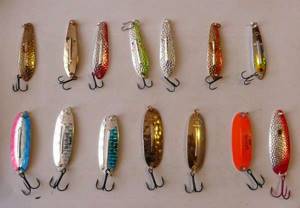
There are many fishing lines that are actively used for catching predatory fish in the summer. However, the most popular and productive is uniform wiring. It is the simplest, which makes it ideal for beginner anglers. The “game” of the bait is carried out due to its shape, size and other individual characteristics. To produce it, you need to cast the lure and let it sink to the bottom, then use a reel to slowly bring it to the shore.
Williams lure for pike
In fact, all wobblers of different sizes are essentially one spinner without any design changes. A slightly convex wide vibrator with a characteristic “ridge” along the central axis, which has become a kind of calling card of the Wabbler line from Williams.
The spine of the spinner is so recognizable that there are at least two dozen Chinese fakes and “Williams” replicas on the market with just such a spine along the central axis.
Williams Wobblers work well in bodies of water with a slow current or no current at all, where they show themselves to be the most catchy lures for pike and large trophy perch.
These can be lakes, reservoir bays, backwaters, places in front of dams on small rivers, and areas between direct and reverse flows on fast rivers.
As mentioned above, the main game of Williams Wabler lures occurs not on the reel, but during the pause.
Therefore, when fishing with a spinning rod, these baits animate at a slow pace, giving long pauses between short periods of reeling. That is, for every 3 turns of the coil you can give up to 5-10 seconds of pause. You can let the bait sink to the bottom if the bottom in the fishing area is relatively clean.
Of course, you can fish with a wobbler in snags, but only if you are calm about losing such expensive baits on the hooks. Otherwise, negative emotions can ruin your entire fishing trip - the Wobbler is a catchy and, at the same time, very catchy lure.
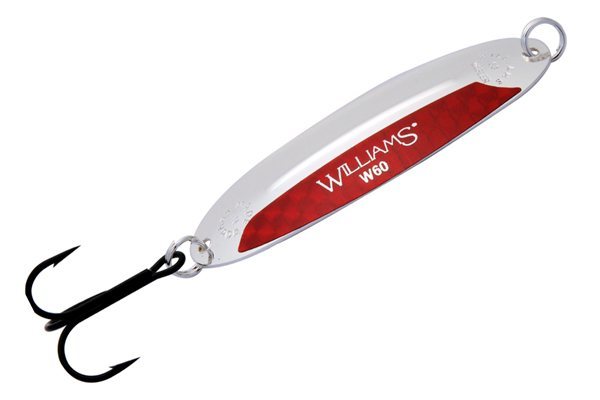
In winter, under the ice you can catch pike and pike perch using the main line of Wobblers and their lightweight models. The gliding spoon moves far from the hole, each time after the start of gliding in a new direction.
This allows you to fish a significant space under the hole and provoke a greedy pike or slow pike perch to bite.
To be able to fish in shallow places or in free water above aquatic vegetation in overgrown reservoirs, it is worth including lightweight Williams Wobbler Light lures for pike in your arsenal.
Due to the fact that the linear dimensions of the baits remain the same, and their thickness is reduced, Williams Wabler Lite spinners are excellent at a slow pace in shallow depths.
The animation of these lures is exactly the same as the main line lures, maybe a little slower.
